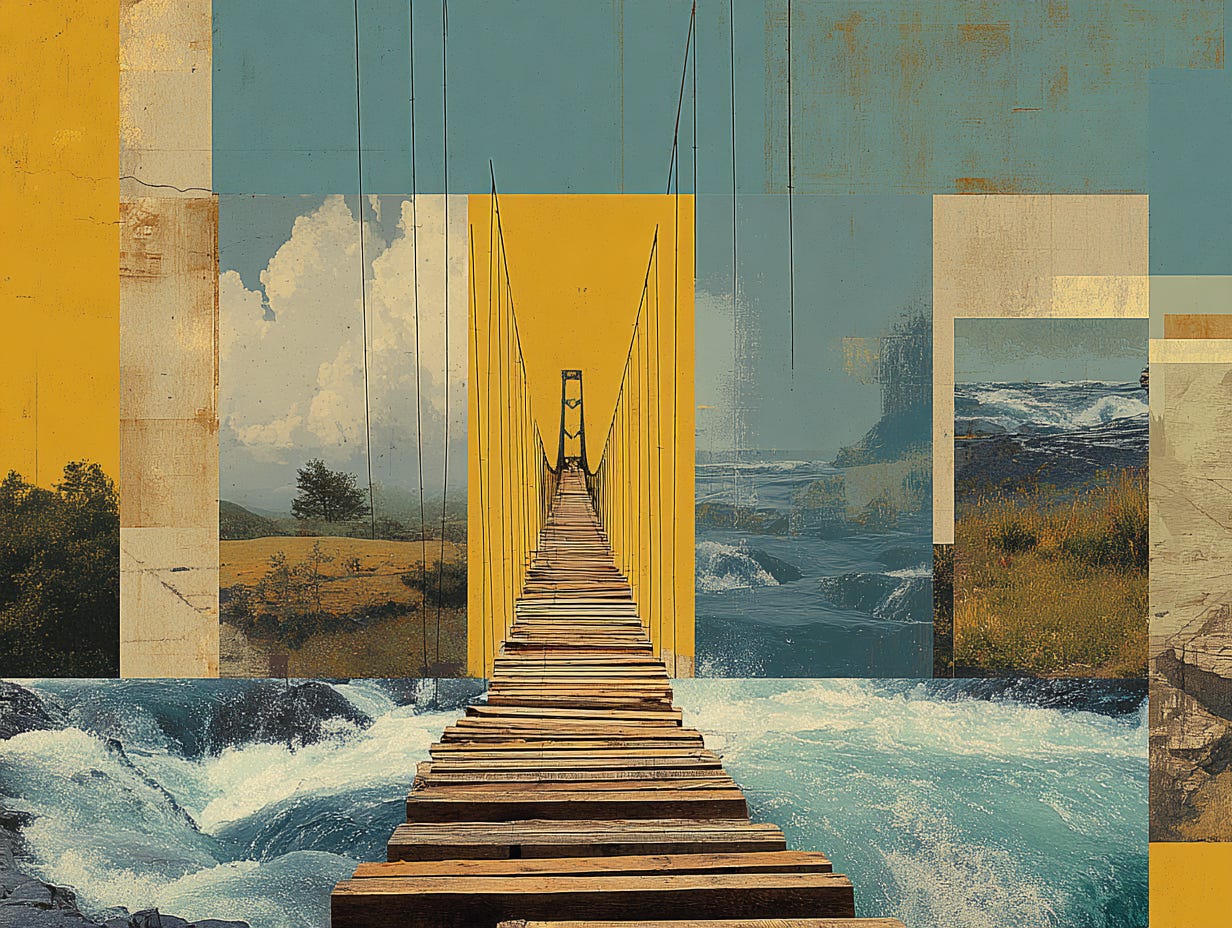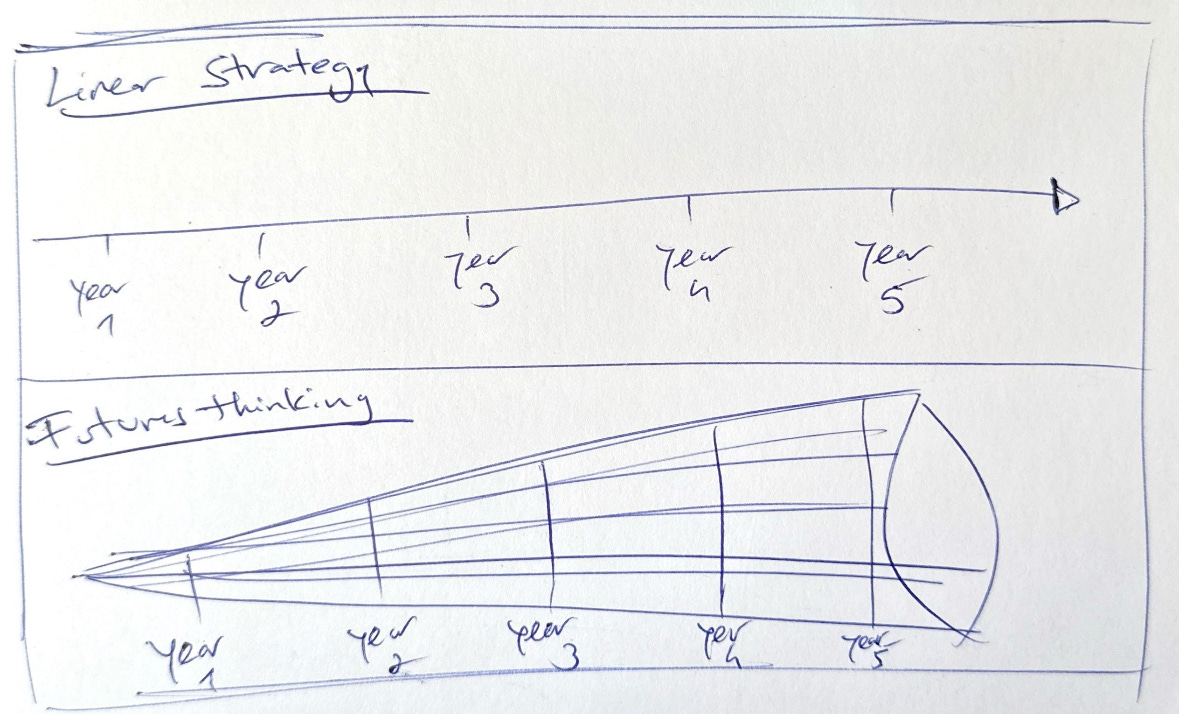Futures Thinking Isn’t About Prediction. It’s About Possibility.
In a world of compounding crises, it’s time we stopped solving for the next quarter- and started designing for the next decade.
Picture this: you’re walking across a bridge that’s still being built in front of you, plank by plank, bolt by bolt, as the river swells below and the wind shifts direction. There’s no map. No railing. Just a vague sense of where you’re headed and a deep belief that forward is better than back.
That’s what it feels like to lead anything right now.
Global systems are glitching. Supply chains are unraveling, algorithms are outpacing legislation, forests are burning, billionaires are playing astronaut and dreaming of planet B. Yet, most strategies are still composed in the language of KPIs and annual performance targets, as if the world were not already on fire.
In the face of this volatility, we keep reaching for certainty, ritualizing control through annual plans and tidy forecasts. But there’s a particular madness in pretending we know where things are going.
That madness lives in five-year plans drawn with the confidence of a deity and the imagination of a filing cabinet. It takes up residence in boardrooms where “strategy” means rearranging deck chairs on a ship bound for the iceberg. It echoes in the way we keep asking, How do we get through this quarter? This year? How do we survive? - even as glaciers melt, algorithms evolve, and the foundations of society buckle under pressure that no spreadsheet can predict.
Futures thinking may not be a cure for that madness, but it is a way out of the trance- a way to break the spell of the endlessly urgent present. It gives us permission to stop pretending we know exactly where things are going, and to instead ask both where we want to go, and how can we be better prepared for what may come.
While five-year plans cling to the illusion of certainty: fixed milestones, neat predictions, rigid roadmaps. Futures thinking does the opposite. It trades false confidence for curiosity, linear forecasts for multiple possibilities.
Despite what the name might suggest, futures thinking isn’t about prediction. Prediction is what you do when you believe the future is a single thread waiting to be unraveled. Futures thinking is what you do when you realize the future is a forest. Not a neat one, but a wild, tangled, living forest, but one that’s dense with possibility, risk, beauty…. and things with teeth.
To navigate through this forest you don’t need a machete, you need curiosity, imagination, and a compass made of questions to guide your path.
So what is it, really?
Futures thinking is a long-standing discipline (and a practice!) that helps organizations explore what might be possible- so they can act more intentionally in the present. It’s a kind of structured dreaming for people who also love spreadsheets. It invites you to loosen your grip on what’s “likely” and consider instead what’s possible, and even more dangerously, what’s preferable.
It doesn’t ask you to guess the future. It asks you to notice it whispering through the cracks of the present. It teaches you to scan for signals others overlook, to listen to the outliers, to take emerging trends and conflicting truths and imagine where they might lead.
Futures thinking and strategic foresight have been used for decades across governments, corporations, and social movements, drawing on a wide set of tools: scenario planning, horizon scanning, backcasting, systems mapping, speculative artifacts, and more. These aren’t magic tricks or abstract thought experiments. They are scaffolding for imagination, structures we build to dance with risk, glimpse alternatives, and practice decision-making before the moment arrives. They offer a structured and tested framework for navigating uncertainty and surfacing new options.
This is not a luxury reserved for think tanks. The goal isn’t to produce a glossy forecast or a trend report packed with pastel infographics and bulletproof numbers. Futures thinking is a rigorous creative process—a circus act of building strategy midair, while the ground beneath you shifts, like a tightrope walker in platform boots.
At its heart, futures thinking begins with a quiet rebellion: the refusal to accept the future we’ve been handed.
It challenges the idea that tomorrow is predetermined by today’s headlines. It pushes back on the narrowness of inherited forecasts and opens space to ask: What if we designed something better? And how might we prepare for what we can’t yet see?
This isn’t easy work. When the present feels endlessly urgent, sitting down to imagine the year 2035 can feel indulgent, or even impossible. But that’s exactly the spell futures thinking breaks. It helps us move from reactive crisis response to long-view action. Not by offering certainty, but by helping us navigate complexity. It builds our fluency in ambiguity, inviting us to dance with uncertainty instead of barricading against it. And it invites imagination back into the boardroom, not as decoration, but as a critical tool for navigating change.
When done well, futures thinking doesn’t just produce a set of potential scenarios- it shifts how we see. It reveals assumptions we didn’t realize we were carrying. It surfaces weak signals of change we’ve learned to ignore. It gives us tools to explore what’s next before it arrives, and to build toward the future we want, rather than the one we fear.
In doing so, it reminds us that we are not just passengers on a runaway train- we are also the ones laying the tracks.
What does it look like in practice?
Futures thinking doesn’t live in a single workshop or a visionary keynote. It’s most powerful when embedded into the way organizations plan, learn, listen, and make decisions. That can mean building scenarios to test strategy under multiple futures. It can mean using signals mapping to track emerging shifts in community needs. It might look like creating speculative artifacts to provoke conversation, or holding future-back planning sessions that reverse-engineer strategy from a preferred horizon.
These exercises help to sharpen resilience, deepen strategic clarity, and expand the range of what’s possible, without losing grip on reality.
A dash of inspiration: The Robert Wood Johnson Foundation-Embedding Foresight in Philanthropic Strategy
The Robert Wood Johnson Foundation (RWJF), one of the largest public health funders in the United States, is among the most prominent philanthropic actors to embed futures thinking at a strategic level. Unlike many foundations that engage in foresight episodically, publishing a scenario report or convening a trends panel, RWJF has institutionalized it across programs, grants, and internal processes. Foresight is not an accessory; it’s a core method for reimagining the systems that shape health outcomes in the U.S.
At the center of this work is their Ideas for an Equitable Future initiative, which supports visionary thinkers (scientists, anthropologists, technologists, creatives, and community leaders) to explore how emerging forces might shape health and equity over the next 10 to 100 years. The foundation provides grant funding to speculative research, scenario development, trend analysis, as well as unconventional experiments that challenge dominant assumptions about how health is produced, valued, and distributed.
This isn’t abstract. RWJF has backed scenario planning on the future of caregiving and public health, speculative fiction to challenge linear narratives of health progress, and systems mapping to explore AI’s role in decision-making and public trust. Their Work and Health initiative explores how shifts in labor, automation, caregiving burdens, may impact wellbeing over time.

They’ve also invested in capacity-building. The Social Work Health Futures Lab, supported by RWJF, trains social work fellows in strategic foresight tools over 18 months, helping practitioners anticipate and influence systemic changes rather than just respond to crisis. Through this and other efforts, the foundation is helping to build a pipeline of professionals fluent in long-term, equity-centered thinking.
Critically, RWJF’s foresight work doesn’t aim to predict a singular future. It’s designed to surface divergent possibilities, interrogate root causes of health inequity (especially structural racism), and chart transformative pathways forward. Their approach aligns with “critical futures” practice, using foresight not just to explore what’s likely, but to expand the space of what’s possible and preferable. And by explicitly valuing community knowledge as a valid and necessary input, RWJF ensures that its futures work reflects the lived realities of those most affected by inequity- not just institutional perspectives.
RWJF’s use of these tools shows how futures thinking can move beyond theory- becoming a practical operating system for philanthropic strategy in complex, rapidly changing environments.
LEAPO Futures is a laboratory for radical imagination, where strategy, storytelling, and a space for organizations to step out of reaction mode and design strategies rooted in the futures they want to create.
Curious how this could look in your own work? Let’s talk.




